Two types of microscopes - Study guides, Class notes & Summaries
Looking for the best study guides, study notes and summaries about Two types of microscopes? On this page you'll find 314 study documents about Two types of microscopes.
Page 4 out of 314 results
Sort by
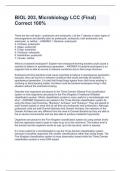
-
BIOL 203, Microbiology LCC (Final) Correct 100%
- Exam (elaborations) • 47 pages • 2024
-
Available in package deal
-
- $15.49
- + learn more
There are two cell types - prokaryotic and eukaryotic. List the 7 classes or basic types of microorganisms and identify each as prokaryotic, eukaryotic, both prokaryotic and eukaryotic, or neither. - ANSWER 1. Bacteria- prokaryotic 2. Archaea- prokaryotic 3. Algae- eukaryotic 4. Fungi- eukaryotic 5. Protozoa- eukaryotic 6. Helminthes- eukaryotic 7. Viruses- neither What is a bacterial endospore? Explain how endospore-forming bacteria could cause a scientist to believe in spontaneous gen...
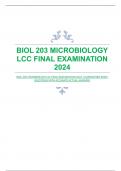
-
BIOL 203 MICROBIOLOGY LCC FINAL EXAMINATION 2024 |GUARANTEED EXAM QUESTIONS WITH ACCURATE ACTUAL ANSWERS
- Exam (elaborations) • 61 pages • 2024
-
- $17.49
- + learn more
There are two cell types - prokaryotic and eukaryotic. List the 7 classes or basic types of microorganisms and identify each as prokaryotic, eukaryotic, both prokaryotic and eukaryotic, or neither. - Accurate Answer1. Bacteria- prokaryotic 2. Archaea- prokaryotic 3. Algae- eukaryotic 4. Fungi- eukaryotic 5. Protozoa- eukaryotic 6. Helminthes- eukaryotic 7. Viruses- neither What is a bacterial endospore? Explain how endospore-forming bacteria could cause a scientist to believe in spontan...

-
AQA GCSE Triple Science – Biology Exam Questions and Answers
- Exam (elaborations) • 51 pages • 2024
- Available in package deal
-
- $13.49
- + learn more
AQA GCSE Triple Science – Biology Exam Questions and Answers What are eukaryotic cells? - Answer️️ -Cells that are more complex and have a nucleus (animal and plant cells) What are prokaryotic cells? - Answer️️ -Cells that are smaller and simpler, and don't have a nucleus but still have genetic information (bacteria) What are eukaryotes? - Answer️️ -Organisms made of eukaryotic cells What is a prokaryote? - Answer️️ -A prokaryotic cell (it's a single celled organism) ...

-
BMSC 210 Midterm 1 Study Guide | 100% Correct Answers | Verified | Latest 2024 Version
- Exam (elaborations) • 30 pages • 2024
-
- $10.49
- + learn more
What are properties of all cells? - Growth Metabolism Evolution LUCA - Last universal common ancestor How do we decide how the phylogenetic tree is drawn? - Use ribosomes. All organisms have it and it has been the same for billions of years What are the domains? - Bacteria Archaea Eukarya What defines the domains of cells? - Their rRNA sequencing What domains are most closely related? - Archaea and eukarya What emerged from Archaea? - Eukarya How do we know kw when oxygen appeare...
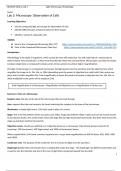
-
BIOS 242 Lab 3: Microscopy- Observation of Cells
- Other • 11 pages • 2023
-
- $19.49
- + learn more
Lab 3: Microscopy- Observation of Cells Learning Objectives: Use the compound light microscope for observation of cells. Identify different types of bacteria based on their shapes. Identify a variety of eukaryotic cells. VIDEOS: a) How to Use a Compound Microscope (Elon TLT) b) Parts of the Compound Microscope (Tami Guy) Introduction: Microbiology is the study of organisms, which cannot be seen with naked eye. You will need help of a microscope to observe these “tiny anim...
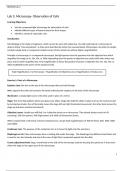
-
BIOS 242 Week 2 Assignment; Lab 3 of 14 Onsite; Microscopy Observation of Cells
- Other • 10 pages • 2024
-
- $9.99
- + learn more
BIOS 242 Week 2 Assignment; Lab 3 of 14 Onsite; Microscopy Observation of Cells Lab 3: Microscopy- Observation of Cells Learning Objectives: Use the compound light microscope for observation of cells. Identify different types of bacteria based on their shapes. Identify a variety of eukaryotic cells. Introduction: Microbiology is the study of organisms, which cannot be seen with naked eye. You will need help of a microscope to observe these “tiny animalcules” as they w...
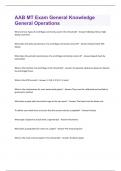
-
AAB MT Exam General Knowledge General Operations Questions With Complete Solutions
- Exam (elaborations) • 3 pages • 2024
- Available in package deal
-
- $7.19
- + learn more
What are four types of centrifuges commonly used in the clinical lab? - Answer-Tabletop, Micro, HighSpeed, and Ultra. What does the daily maintenance of a centrifuge commonly consist of? - Answer-Cleaned with 10% bleach What does the periodic maintenance of a centrifuge commonly consist of? - Answer-Speed check by tachometer What is the function of a centrifuge in the clinical lab? - Answer-To separate substances based on density by centrifugal forces. What is the RCF formula? - Answer-1....
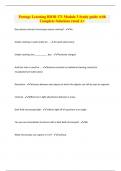
-
Portage Learning BIOD 171 Module 3 Study guide with Complete Solutions rated A+
- Exam (elaborations) • 4 pages • 2024
-
Available in package deal
-
- $9.99
- + learn more
Portage Learning BIOD 171 Module 3 Study guide with Complete Solutions rated A+ Does phase contrast microscopy require staining? - No Simple staining is used mostly for... - A quick observance Simple staining uses __________ dye. - Positively charged Acid fast stain is used for... - bacteria resistant to traditional staining; mostly for mycobacterium tuberculosis Resolution - distance between two objects at which the objects can still be seen as separate Contrast - difference in light abso...
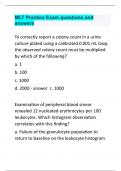
-
MLT Practice Exam questions and answers.
- Exam (elaborations) • 22 pages • 2024
-
- $16.49
- + learn more
To correctly report a colony count in a urine culture plated using a calibrated 0.001 mL loop, the observed colony count must be multiplied by which of the following? a. 1 b. 100 c. 1000 d. 2000 c. 1000 Examination of peripheral blood smear revealed 12 nucleated erythrocytes per 100 leukocytes. Which histogram observation correlates with this finding? a. Failure of the granulocyte population to return to baseline on the leukocyte histogram b. Shift to the left of the erythrocyte po...
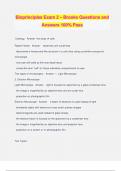
-
Bioprinciples Exam 2 – Brooks Questions and Answers 100% Pass
- Exam (elaborations) • 42 pages • 2024
- Available in package deal
-
- $13.49
- + learn more
Bioprinciples Exam 2 – Brooks Questions and Answers 100% Pass Cytology - Answer- the study of cells Robert Hooke - Answer- - observed cork could float - discovered a honeycomb-like structure in a cork slice using a primitive compound microscope - only saw cell walls as this was dead tissue - coined the term "cell" for these individual compartments he saw Two types of microscopes: - Answer- 1. Light Microscope 2. Electron Microscope Light Microscope - Answer- - light is focused on s...

How did he do that? By selling his study resources on Stuvia. Try it yourself! Discover all about earning on Stuvia


